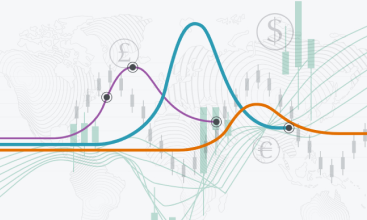Global inflation forecast:
Will prices come down in 2024?
- J.P. Morgan Research forecasts global core inflation will remain sticky at around 3% in 2024.
- In the U.S., inflation has cooled significantly but still remains above target. Against a challenging growth backdrop, the road to lower inflation also looks bumpy in the U.K. and the Euro zone.
- In China, deflationary pressures will likely ease in 2024, with headline CPI inflation trending up modestly to 0.9% year-over-year and core CPI inflation reaching 1.2%.
- In emerging markets (ex-China and Türkiye), J.P. Morgan Research expects both core and headline inflation to decline by 100 basis points (bp) over the course of 2024.
Inflation has been slowing across the globe, raising hopes of a soft landing in 2024. However, while core goods prices are stabilizing in many regions, core services prices remain elevated and labor markets are still tight.
How will these dynamics play out in the coming months, and what’s the global inflation forecast for 2024? Explore our interactive global inflation map below.
Global CPI forecast
core CPI, %oya
Source: National statistics, J.P. Morgan forecasts. Figures as of February 5, 2024.
In most global markets, core CPI is expected to come down as 2024 progresses. China is the exception — here, core CPI is expected to trend up modestly to 1.2% by December 2024.
Global
J.P. Morgan Research forecasts global core inflation will remain sticky at around 3% in 2024. “Although headline inflation is expected to drop, we look for a fading of goods price deflation. At the same time, tight labor markets and solid demand growth is expected to limit disinflation in service prices,” said Bruce Kasman, Chief Economist at J.P. Morgan.
The divergence between core goods and core services inflation has widened in recent months, as shown in the chart below. Core goods prices have stalled, reflecting the broader disinflationary impulse from weak manufacturing activity and falling China export prices. “However, while much of the recent inflation slide has stemmed from goods prices, a key risk for the new year is a reversal of these price declines. For instance, recent shipping and airfreight cost indicators have moved up and delivery times have started to lengthen again,” observed Nora Szentivanyi, Senior Economist at J.P. Morgan. Core goods prices will likely return to modest positive gains in the first half of 2024, according to J.P. Morgan Research estimates.
On the other hand, the strength in core services inflation remains striking and is fairly uniform across regions, reflecting still-tight labor markets. “More noticeable cooling in labor markets may be required to bring core services inflation meaningfully lower and ratify market expectations for early easing by developed market (DM) central banks,” Szentivanyi added. Against this backdrop, J.P. Morgan Research forecasts only a moderate slowing in service price inflation to 4%ar in the first half of 2024.
Progress on lowering inflation from its 2021–23 heights should allow the Federal Reserve (Fed) and other major central banks to ease policy. “But our forecast of firming core goods inflation and sticky service price inflation will likely limit the size of this easing relative to current market pricing, absent a more tangible threat to growth,” Kasman said.
Global core CPI (ex-China and Türkiye)
Source: National sources, J.P. Morgan
Global core goods inflation has fallen significantly in 2023, while global core services inflation has remained sticky.
U.S.
“Inflation has cooled significantly relative to earlier boomy highs from the past few years, but still remains above target. Weakening in core goods inflation has been an important moderating force for overall inflation, but core services prices excluding housing have cooled much less noticeably lately,” said Michael Feroli, Chief U.S. Economist at J.P. Morgan. “Absent a recession next year, we don’t see inflation getting all the way back down to 2%.”
Core goods prices in the U.S. have been roughly flat throughout 2023, reflecting a near-return to pre-pandemic trends. However, inflation in the services sector has been more resilient. “In 2024, while the unwinding of supply chain shocks could deliver further disinflation, we think the ‘final mile’ of getting inflation down will require a softer labor market,” Feroli said. “We are already seeing wage inflation slow and we think the labor market should soften over time as the economy is impacted by higher interest rates. This should allow core services prices to moderate, working to bring broader inflation aggregates closer to target.”
Overall, while U.S. policymakers will likely be focusing on core inflation measures in 2024, changes in food and energy prices could also be significant. “After a strong run throughout much of 2021 and 2022, food price inflation settled down to a more moderate trend of 0.2% monthly gains in 2023, and we look for similarly unexciting increases moving forward,” Feroli noted. “Swings in energy could be important, but we believe that any upcoming big changes would be more likely related to factors such as geopolitical events.”
U.K.
In the U.K, core inflation is expected to remain elevated in 2024, reaching 3.1% in both June and December. “Inflation has fallen quickly from its double-digit peak, but the journey in core from 5% all the way back down to 2% will be the hardest,” said Allan Monks, Chief U.K. Economist at J.P. Morgan.
As with the U.S., the persistence of inflation in the U.K. is largely due to services prices, which were up 0.7% month-over-month in December 2023. However, recent inflation prints and an expected decline in the Ofgem energy price cap in April provide some optimism.
“Unless market pricing changes significantly or there are further large surprises on core, this looks set to take headline inflation down toward 1.6% in the second quarter of 2024, albeit on a temporary basis if our view that core inflation will remain above target is correct,” Monks said. “The optics of headline inflation falling below 2% in April will put more pressure on the Monetary Policy Committee (MPC) to start cutting rates earlier than it has previously indicated, and owing to the broad improvement in core inflation, we are bringing forward our call for the first cut of 25 bp from November to August.”
Euro zone
Similarly in the Euro area, the road to lower inflation looks bumpy. “Over the past two years, high inflation in the region was driven not only by energy, food and supply shocks, but also by a sharp increase in corporate profit margins and wage growth,” said Greg Fuzesi, Euro Area Economist at J.P. Morgan. “While the fading of transitory forces has already slowed the momentum in core prices to a 3% pace, further progress requires corporate pricing and wage growth to moderate.”
However, the fact that the growth outlook for the region is challenging makes a full disinflation back to the European Central Bank’s (ECB) 2% target more likely. “The ‘final mile’ is harder but more likely to be completed when the economy is at best sluggish. The weaker the economy, the greater the likelihood that inflation ultimately returns back to target,” Fuzesi added. Overall, core inflation in the Euro area is expected to average at 2.6% in 2024.
China
The picture is markedly different in China, where the domestic economy is grappling with deflation. “Multiple factors have contributed to deflationary pressure in China, including global commodity price declines, food price drags and policy support for supply rather than demand,” said Haibin Zhu, Chief China Economist at J.P. Morgan. “However, we expect deflation will end but low inflation will stay in place in 2024.”
Volatile pork prices have been the key driver of food deflation in China. However, the annual change in live pig stock, which tends to lead pork prices by three to six months, has stabilized in recent times. Plus, with oil prices expected to stay range-bound at around $83/bbl in 2024, deflationary pressures from imported energy prices will likely ease in the coming months.
“In the absence of a shift in policy direction from supporting supply to demand, the asymmetric recovery in retail sales and industrial production will stay in place, constraining room for core CPI to turn up. The inflation impulse from China’s reopening will also gradually fade into next year,” Zhu added. “Taken together, we expect headline CPI inflation to trend up modestly to 0.9% year-over-year on average in 2024, and core CPI inflation to reach 1.2%.”
Emerging markets (EM)
In EM (ex-China and Türkiye), J.P. Morgan Research expects both core and headline inflation to decline by 100 bp over the course of 2024. However, in a handful of economies — including Poland, Hungary, Romania and Colombia — core inflation is still likely to exceed central bank targets by around 2 percentage points, reflecting some combination of tight labor markets, loose fiscal policy and unanchored inflation expectations.
“While the progress on core disinflation in EM has been impressive, it has been overly reliant on collapsing core goods inflation. However, this could change as the disinflationary impulse from a reversal of last year’s supply chain dislocations and China’s contracting export prices begins to fade,” said Jahangir Aziz, Head of Emerging Market Economics Research at J.P. Morgan. “On the other hand, the latest run rates on core services inflation call attention to the underlying stickiness in core inflation in parts of Latin America and Central and Eastern Europe. Overall, a key risk in 2024 is for persistent services inflation to combine with reaccelerating goods prices to keep core inflation above target mid-points.”

RESEARCH
Market outlook for 2024: Slow global growth clouds forecast for equities
December 13, 2023
What does the challenging macro backdrop of sluggish growth and stubborn inflation mean for markets?

RESEARCH
Deflation in China: The spillover effects for global markets
September 28, 2023
What’s the impact of China’s deflation pressures, and will prices continue to fall?

RESEARCH
What’s the impact of slowing interest rate hikes?
February 22, 2023
Is the tightening cycle over yet? Discover what a slowdown in interest rate hikes could mean and why global bond markets are rallying.
Disclaimer:
This communication is provided for information purposes only. Please read J.P. Morgan research reports related to its contents for more information, including important disclosures. JPMorgan Chase & Co. or its affiliates and/or subsidiaries (collectively, J.P. Morgan) normally make a market and trade as principal in securities, other financial products and other asset classes that may be discussed in this communication.
This communication has been prepared based upon information, including market prices, data and other information, from sources believed to be reliable, but J.P. Morgan does not warrant its completeness or accuracy except with respect to any disclosures relative to J.P. Morgan and/or its affiliates and an analyst's involvement with any company (or security, other financial product or other asset class) that may be the subject of this communication. Any opinions and estimates constitute our judgment as of the date of this material and are subject to change without notice. Past performance is not indicative of future results. This communication is not intended as an offer or solicitation for the purchase or sale of any financial instrument. J.P. Morgan Research does not provide individually tailored investment advice. Any opinions and recommendations herein do not take into account individual client circumstances, objectives, or needs and are not intended as recommendations of particular securities, financial instruments or strategies to particular clients. You must make your own independent decisions regarding any securities, financial instruments or strategies mentioned or related to the information herein. Periodic updates may be provided on companies, issuers or industries based on specific developments or announcements, market conditions or any other publicly available information. However, J.P. Morgan may be restricted from updating information contained in this communication for regulatory or other reasons. Clients should contact analysts and execute transactions through a J.P. Morgan subsidiary or affiliate in their home jurisdiction unless governing law permits otherwise.
This communication may not be redistributed or retransmitted, in whole or in part, or in any form or manner, without the express written consent of J.P. Morgan. Any unauthorized use or disclosure is prohibited. Receipt and review of this information constitutes your agreement not to redistribute or retransmit the contents and information contained in this communication without first obtaining express permission from an authorized officer of J.P. Morgan. Copyright 2024 JPMorgan Chase & Co. All rights reserved.






